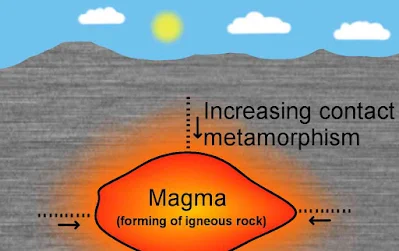Contact Metamorphism: Causes, Examples, Occurrence
Contact metamorphism is a type of metamorphism that occurs when rocks are heated by the intrusion of hot magma. The heat from the magma causes the surrounding rocks to recrystallize and form new minerals.
The changes that occur are greatest wherever the magma comes into contact with the rock because the temperatures are highest at this boundary and decrease with distance from it. Around the igneous rock that forms from the cooling magma is a metamorphosed zone called a contact metamorphism aureole.
Contact Metamorphism Causes
Contact metamorphism is caused by the heat and fluids released by a magma intrusion into surrounding rocks. The intensity of the metamorphism depends on the temperature of the magma, the size of the intrusion, and the type of country rock being intruded.
The heat from the magma causes the surrounding rocks to heat up and recrystallize. This process can change the minerals in the rocks, create new minerals, and change the texture of the rocks. For example, limestone can be metamorphosed into marble, and sandstone can be metamorphosed into quartzite.
Where does contact metamorphism occur
Contact metamorphism occurs when rocks are subjected to high temperatures and pressures due to the intrusion of molten magma. This type of metamorphism occurs in the Earth's crust when hot magma forces its way into the surrounding rocks. As the magma intrudes, it heats up the surrounding rocks, causing them to undergo changes in mineralogy and texture.
The zone affected by contact metamorphism is typically localized around the igneous intrusion, and the intensity of metamorphism decreases with distance from the contact zone. The rocks closest to the intrusion experience the highest temperatures and pressures, leading to more significant changes in mineral composition and texture.
Common settings for contact metamorphism include the aureole around igneous intrusions such as plutons, dikes, or sills. Rocks undergoing contact metamorphism may exhibit features like new mineral growth, recrystallization, and the development of specific mineral assemblages characteristic of high-temperature conditions.
Contact Metamorphism Types
Depending on whether the alternation occurs during metamorphism, contact metamorphism can be divided into heat contact metamorphism and contact alternation metamorphism. Heat contact metamorphism doesn’t experience alternation, and the periphery experiences metamorphism due to the heat roast from the lava; contact alternation metamorphism experiences obvious alternation besides the influence of lava heat. Under these two kinds of contact metamorphism, the original rock of different compositions can form different mineral combinations, and the contact metamorphic rock lacks bedding.
The Contact Metamorphism
The product of the contact metamorphism depends mainly on the protolith composition and temperature, secondly on pressure, and the stress effect is not obvious. The original rock with thermal contact metamorphism is mainly mudstone, carbonate rock, clastic rock, and igneous rock that can form different thermal contact metamorphic rock types.
Thermal contact metamorphic rock type of mudstone is spotted slate, knotty slate, and hornstone; carbonate rock will develop into marble after thermal contact metamorphism; clastic rock is not easily changed—under thermal contact metamorphism, if the metamorphism is shallow, the sandy texture still maintains and forms metamorphic sandstone; and igneous rock is generally the combination of high-temperature minerals, thus changing a little under thermal contact metamorphism.
Contact Alternation Metamorphism
Contact alternation happens in the contact zone between the lava intrusion and peripheral rocks, and the evaporate components and hydrothermal solution precipitated in the later lava crystallization with the heat from the lava alternate the peripheral rocks.
Magmatic fluids coming from the intrusive rock may also take part in the metamorphic reactions. An extensive addition of magmatic fluids can significantly modify the chemistry of the affected rocks. In this case the metamorphism grades into metasomatism.
Contact Metamorphism Rock Examples
Marble
Marble is a type of metamorphic rock that is formed from the metamorphism of limestone. Limestone is a sedimentary rock that is composed mostly of the mineral calcite. When limestone is heated and recrystallizes, it forms marble. Marble is often used as a building material or for sculptures.
Hornfels
Hornfels is a fine-grained metamorphic rock that can be formed from a variety of rock types, including shale, sandstone, and limestone. Hornfels is often characterized by its lack of foliation (layering) and its fine-grained texture. Hornfels can be used as a building material or for ornamental purposes. The name "hornfels" is derived from the German words "horn" (meaning horn) and "fels" (meaning rock), reflecting its hard and fine-grained nature.
Quartzite
Quartzite is a type of metamorphic rock that is formed from the metamorphism of sandstone. Sandstone is a sedimentary rock that is composed mostly of the mineral quartz. When sandstone is heated and recrystallizes, it forms quartzite. Quartzite is often used as a building material or for road construction.
Skarns
Sometimes when a siliceous magma intrudes carbonate rocks like limestone and dolostone, significant chemical exchange (metasomatism) takes place between the magma and the carbonate rock. Such a metasomatized rock is refered to as skarn.
If the intruded rock is rich in carbonate the result is a skarn. Fluorine-rich magmatic waters which leave a cooling granite may often form greisens within and adjacent to the contact of the granite. Metasomatic altered aureoles can localize the deposition of metallic ore minerals and thus are of economic interest.
A special type of contact metamorphism, associated with fossil fuel fires, is known as pyrometamorphism.
Contact Metamorphism Vs. Regional MetamorphismThe formation of Foliated Metamorphic Rock
Cataclastic Metamorphism




%20(1).webp)





